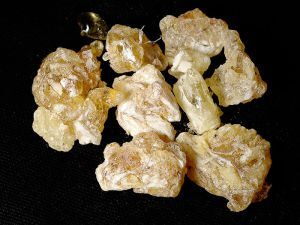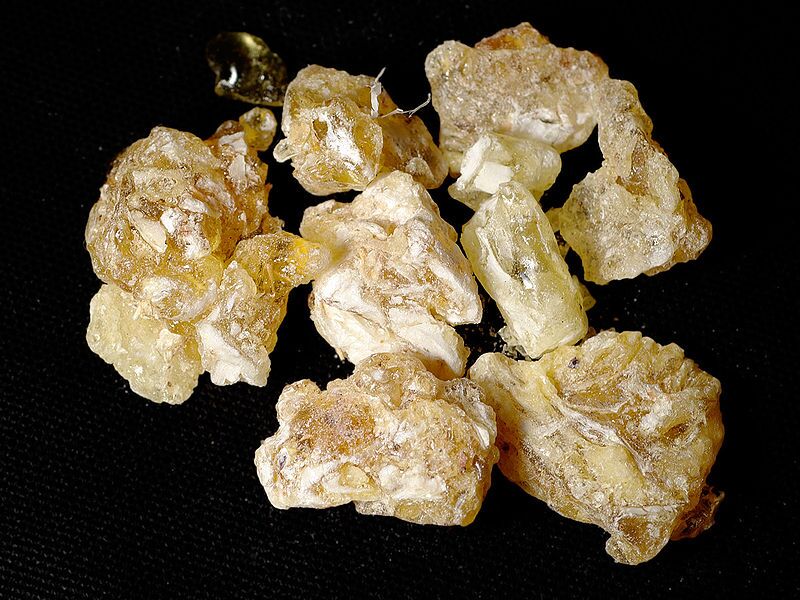
The first scientific evidence of frankincense being used in Roman burial rites in Britain has been uncovered by a team of archaeological scientists led by the University of Bradford. The findings – published today in the Journal of Archaeological Science – prove that, even while the Roman Empire was in decline, these precious substances were being transported to its furthest northern outpost.
The discovery was made by carrying out molecular analysis of materials previously thought to be of little interest – debris inside burial containers and residues on skeletal remains and plaster body casings. Until now, evidence for the use of resins in ancient funerary rites has rarely come to light outside of Egypt.
The samples came from burial sites across Britain, in Dorset, Wiltshire, London and York, dating from the third to the fourth century AD. Of the forty-nine burials analysed, four showed traces of frankincense – originating from southern Arabia or eastern Africa – and ten others contained evidence of resins imported from the Mediterranean region and northern Europe.
Classical texts mention these aromatic, antimicrobial substances as being used as a practical measure to mask the smell of decay or slow decomposition during the often lengthy funeral rites of the Roman elite. But it was their ritual importance which justified their transportation from one end of the empire to the other. Seen both as gifts from the gods and to the gods, these resins were thought to purify the dead and help them negotiate the final rite of passage to the afterlife.
Rhea Brettell from the University of Bradford, whose research is funded by the Arts and Humanities Research Council, was the first to realise that these grave deposits were an untapped reservoir of information which could provide the missing evidence:
“Archaeologists have relied on finding visible resin fragments to substantiate the descriptions of burial rites in classical texts, but these rarely survive,” she says. “Our alternative approach of analysing grave deposits to find the molecular signatures of the resins – which fortunately are very distinctive – has enabled us to carry out the first systematic study across a whole province.”
____________________________________
 An example of Frankincense bought on the market in Somalia. This is not an example of evidence actually found in Roman Britain burials.
An example of Frankincense bought on the market in Somalia. This is not an example of evidence actually found in Roman Britain burials.
______________________________________
These resins were only recovered from burials of higher status individuals, identified from the type of container used, the clothing they were wearing and items buried with them. This is consistent with the known value of frankincense in antiquity and the fact it had to be brought to Britain via what, at the time, was a vast and complex trade route.
University of Bradford Professor of Archaeological Sciences, Carl Heron, who led the research, adds: “It is remarkable that the first evidence for the use of frankincense in Britain should come from such seemingly unpromising samples yet our analysis demonstrates that traces of these exotic resins can survive for over 1700 years in what others would reject as dirt.”
The project was a collaboration between the University of Bradford and specialists at the Anglo-Saxon Laboratory in York, the Museum of London and the Universities of Bamburg and Bordeaux.
Dr Rebecca Redfern, research osteologist in the Centre for Human Bioarchaeology at the Museum of London, said: “This eye opening study has provided us with new and amazing insights into the funerary rituals of late Roman Britain. The University of Bradford’s significant research has also rewarded us with further understanding of a rich young Roman lady, used in the study, whose 4th century skeleton and sarcophagus was discovered near Spitalfields Market in the City of London in 1999, making her burial even more unique in Britain.”
The materials from which the samples were collected are held by Dorset County Museum, Museum of London, Swindon Museum and Art Gallery, Wessex Archaeology, Winchester Museums and York Museums Trust.
The resins found in the study were from three different plant families:
- Pistacia spp. (mastic/terebinth) from the Mediterranean or the Levant
- Pinaceae (probably Pinus spp.) from Northern Europe
- Boswellia spp. (frankincense/olibanum) from southern Arabia and eastern Africa
This study published in Journal of Archaeological Science covers inhumation burials. The University of Bradford researchers have subsequently also identified resins in a cremation burial from the Mersea Island barrow, where the resins were added to the ashes in the urn prior to burial. These findings are due to be published in the New Year.
_____________________________________
Source: University of Bradford press release.
______________________________________________
Just released!
The special new premium quality print edition of Popular Archaeology Magazine. A beautiful volume for the coffee table.
Travel and learn with Far Horizons.
Read about the most fascinating discoveries with a premium subscription to Popular Archaeology Magazine. Find out what Popular Archaeology Magazine is all about. AND MORE:
On the go? Get the smartphone version of Popular Archaeology as an app or as an ebook.
Popular Archaeology’s annual Discovery Edition eBook is a selection of the best stories published in Popular Archaeology Magazine in past issues, with an emphasis on some of the most significant, groundbreaking, or fascinating discoveries in the fields of archaeology and paleoanthropology and related fields. At least some of the articles have been updated or revised specifically for the Discovery edition. We can confidently say that there is no other single issue of an archaeology-related magazine, paper print or online, that contains as much major feature article content as this one. The latest issue, volume 2, has just been released. Go to the Discovery edition page for more information.







